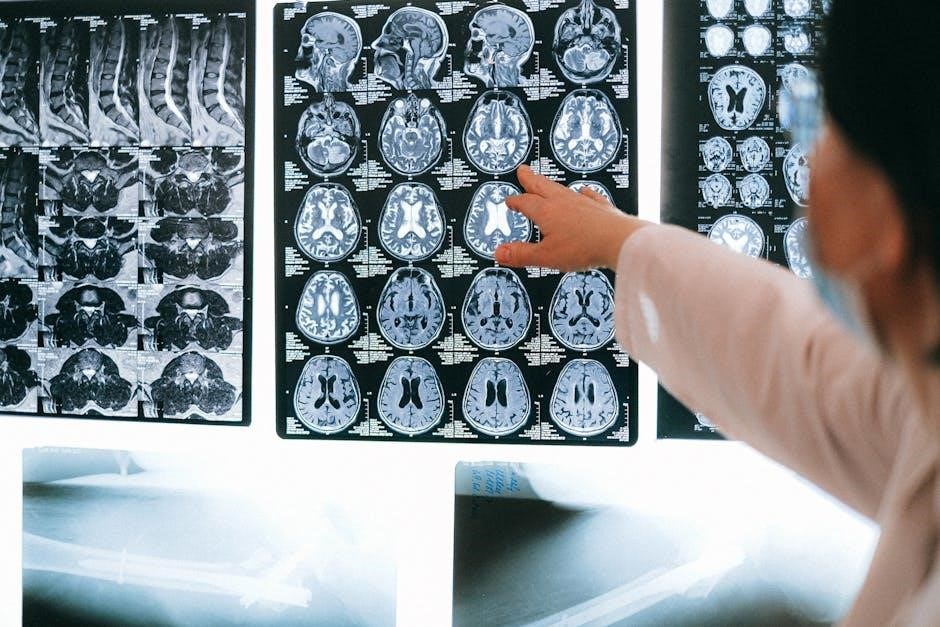shoulder examination pdf

Shoulder Examination PDF: A Comprehensive Guide
This guide provides a structured approach to shoulder examination, crucial for diagnosing various shoulder pathologies. It uses best practices and protocols available in PDF documents. This helps improve diagnostic accuracy!
A comprehensive shoulder examination is paramount for accurately diagnosing shoulder pathologies. This examination integrates history taking, physical assessment, and appropriate imaging considerations. The modular approach allows clinicians to tailor the examination based on initial findings, enhancing diagnostic efficiency. The goal is to identify the source of pain, assess the range of motion, and evaluate the structural integrity of the shoulder joint. A detailed examination helps differentiate between various conditions like rotator cuff injuries, impingement syndromes, and other musculoskeletal issues. Proper documentation is essential for tracking patient progress and informing treatment decisions.

Anatomy Overview
Understanding shoulder anatomy is fundamental for accurate diagnosis. This knowledge informs effective physical examination, guiding palpation and range of motion assessments. Key structures include muscles, tendons, ligaments, and bones.
Key Anatomical Structures
The shoulder’s intricate anatomy includes the rotator cuff muscles (supraspinatus, infraspinatus, teres minor, subscapularis), which provide stability and movement. Bony structures such as the humerus, scapula, and clavicle form the shoulder joint. Ligaments like the glenohumeral ligaments and the coracoclavicular ligaments ensure joint integrity. Key areas like the supraspinous and infraspinous fossae and the acromioclavicular (AC) joint are crucial for understanding potential injury sites. Effective examination requires a detailed knowledge of these structures to differentiate between normality and abnormality, facilitating accurate diagnosis and targeted treatment plans.
Importance of Anatomical Knowledge in Examination
A thorough understanding of shoulder anatomy is paramount for accurate physical examinations. Knowledge of the rotator cuff muscles, bony landmarks, and ligaments enables precise palpation and identification of tenderness or abnormalities. Recognizing the locations of the supraspinous fossa or AC joint assists in pinpointing potential sources of pain and dysfunction. This anatomical insight guides the selection of appropriate orthopedic and special tests, enhancing diagnostic accuracy. Without this knowledge, differentiating between various shoulder pathologies, such as rotator cuff tears or impingement, becomes challenging, leading to misdiagnosis and ineffective treatment strategies for patients.

History Taking
Gathering a detailed patient history is crucial. Focus on the patient’s age, pain location, and mechanism of injury. These details can significantly narrow down the differential diagnosis early in the evaluation.
Essential Questions to Ask
When taking a patient’s history, inquire whether the pain radiates below the elbow. Ascertain the exact location of the pain and how it started. Understanding the mechanism of injury helps identify potential causes, such as trauma or overuse. Ask about previous treatments or similar episodes. Also, determine how the pain affects daily activities and sleep. Consider the patient’s occupation and recreational activities, as these may contribute to the problem. Finally, explore any neurological symptoms. These are numbness or tingling, to rule out nerve involvement in the shoulder.
Patient’s Age and Pain Location
The patient’s age and the precise location of pain are pivotal in guiding the shoulder examination and narrowing the differential diagnosis. Different age groups are prone to specific shoulder pathologies, such as rotator cuff tears in older individuals and instability in younger patients. Pain location helps pinpoint the affected structures. For example, anterior pain might suggest biceps pathology. Lateral pain could involve the rotator cuff, and posterior pain might indicate AC joint issues. Therefore, correlating age with pain location is critical for tailoring the physical examination and formulating an accurate diagnosis.

Physical Examination Protocols
Effective shoulder examination utilizes structured protocols. These protocols ensure a systematic assessment of the shoulder, improving diagnostic accuracy. This approach helps in identifying the root cause of shoulder pain and dysfunction.
Modular Approach vs. Dogmatic Protocol
The choice between a modular approach and a dogmatic protocol significantly impacts the efficiency and effectiveness of a shoulder examination. A dogmatic protocol follows a rigid sequence, potentially overlooking nuanced patient-specific issues. Conversely, a modular approach allows for flexibility, adapting the examination based on initial findings and patient history. This adaptability ensures that relevant tests are prioritized, leading to a more targeted and accurate diagnosis. It helps practitioners focus on the most pertinent aspects of the patient’s condition, ultimately enhancing the quality of care provided.
Standard Protocol Components
A standard shoulder examination protocol typically incorporates several key components to ensure a thorough assessment; These include a detailed history taking, comprehensive inspection, palpation for tenderness and swelling, and a range of motion assessment. Orthopedic tests, such as rotator cuff and impingement tests, are essential for identifying specific pathologies. A neurological examination assesses nerve function, while imaging considerations guide the use of X-rays or ultrasound. These components offer a structured framework for evaluating shoulder pain and dysfunction, ensuring no critical area is overlooked during the diagnostic process, and improving patient outcomes.

Inspection
Inspection involves visually assessing the shoulder for atrophy, asymmetry, or skin changes. Observe for swelling or deformities. These observations provide initial clues about underlying pathologies before any tests are performed.
Observing for Atrophy
Careful observation for muscle atrophy is crucial during the inspection phase of a shoulder examination. Atrophy, particularly in the supraspinatus and infraspinatus muscles, may indicate nerve damage or chronic rotator cuff pathology. Significant atrophy suggests long-standing issues, potentially impacting treatment strategies. Compare both shoulders to identify subtle differences. Note any hollowing or flattening of the muscles, which can be indicative of muscle wasting due to disuse or nerve impingement. Document all observations meticulously, as atrophy is an important sign that guides further diagnostic testing and treatment planning.
Assessing for Effusion
During the inspection of a shoulder examination, assess for effusion, or swelling, within the shoulder joint. Effusion suggests inflammation or injury. Look for subtle fullness or bulging around the joint line. Palpation can help detect fluid accumulation; however, visual inspection often provides initial clues. Note any skin changes, such as redness or warmth, which may accompany effusion. Significant effusion can indicate conditions like arthritis, bursitis, or recent trauma. Document the presence, location, and size of any observed effusion, as this information is vital for determining the underlying cause and guiding further diagnostic steps and interventions.

Palpation
Palpation is a crucial step in the shoulder examination, used to identify tenderness, swelling, and anatomical abnormalities. Systematic palpation helps pinpoint the source of pain and guide further assessment.
Identifying Tenderness
During palpation, carefully assess for tenderness over key anatomical structures, as it can indicate specific pathologies. Focus on the rotator cuff tendons, including the supraspinatus, infraspinatus, and subscapularis. Palpate the biceps tendon within the bicipital groove and note any pain upon direct pressure. Evaluate the AC joint for tenderness, suggesting AC joint arthritis or injury. Pay attention to the coracoid process and surrounding ligaments, as tenderness here might indicate coracoid impingement or other related issues. Document the precise location and severity of the tenderness to guide your differential diagnosis.
Assessing for Swelling
Carefully observe the shoulder joint for any signs of swelling, which may indicate inflammation or effusion. Note the location of the swelling, whether it is localized to the anterior, lateral, or posterior aspect of the shoulder. Palpate around the joint line to assess for any fluid accumulation, differentiating between soft tissue swelling and joint effusion. Check for swelling around the AC joint, suggesting AC joint pathology. Compare the affected shoulder to the unaffected side to identify subtle differences. Document your findings, including the size, location, and consistency of any swelling detected, as it helps direct imaging decisions.
Range of Motion Assessment
Evaluating shoulder range of motion (ROM) is critical. It helps identify limitations caused by pain, stiffness, or structural issues. Active and passive ROM must be measured separately.
Active Range of Motion
Active range of motion (AROM) assesses the patient’s ability to move their shoulder through its full range unassisted. Observe for pain, limitations, or compensatory movements. Evaluate flexion, extension, abduction, adduction, internal rotation, and external rotation. Note any asymmetry between sides. AROM deficits may indicate muscle weakness, pain inhibition, or joint stiffness. Patients should actively raise their arm in a frontal plane to identify pain at mid-range. Compare to normative values and the contralateral limb. Document all findings in detail for accurate diagnosis and treatment planning. Observe the patient’s willingness to move and level of discomfort.
Passive Range of Motion
Passive range of motion (PROM) involves the examiner moving the patient’s shoulder, assessing the joint’s anatomical limits. PROM helps differentiate between muscle-related limitations (seen in AROM) and joint-related restrictions. Evaluate flexion, extension, abduction, adduction, internal and external rotation. Note any crepitus, pain, or end-feel abnormalities. PROM exceeding AROM suggests muscle weakness or pain inhibition. Limited PROM may indicate joint capsule tightness, osteoarthritis, or adhesive capsulitis. Compare bilaterally, documenting any differences. Assess the quality of movement and the presence of any guarding. This is crucial for identifying intra-articular pathology and guiding treatment decisions.
Orthopedic Tests
Orthopedic tests are vital for evaluating specific shoulder pathologies. These tests assess structures like the rotator cuff, AC joint, and labrum. They help pinpoint the source of the patient’s pain.
Rotator Cuff Tests
Rotator cuff tests are essential in the shoulder examination to identify tears or impingement. Common tests include the empty can and full can tests, assessing supraspinatus strength and integrity. Other tests, such as the lift-off test, evaluate the subscapularis muscle. These tests help determine the specific rotator cuff muscle affected. Pain or weakness during these maneuvers indicates potential pathology. It is crucial to correlate test results with other examination findings and imaging studies. A comprehensive evaluation ensures accurate diagnosis and treatment planning for rotator cuff disorders.
Impingement Tests (Neer’s, Hawkins)
Impingement tests are used to assess for subacromial impingement in the shoulder. Neer’s test involves passively flexing the patient’s arm while stabilizing the scapula, eliciting pain if impingement is present. Hawkins test involves flexing the shoulder and elbow to 90 degrees, then internally rotating the arm, also provoking pain with impingement. These tests compress the rotator cuff tendons against the acromion. A positive test suggests rotator cuff tendinopathy or bursitis. Local anesthetic injection into the subacromial bursa can help confirm the diagnosis. Results should be interpreted alongside other findings during physical examination.
AC Joint Tests
AC joint tests are used to evaluate the acromioclavicular joint for pathology such as sprains, separations, or arthritis. The AC joint compression test involves adducting the patient’s arm across the chest, stressing the AC joint and eliciting pain if pathology is present. The AC resisted extension test involves having the patient horizontally abduct their arm against resistance, again provoking pain if there is AC joint involvement. Palpation of the AC joint for tenderness and swelling is also important. These tests help differentiate AC joint pain from other shoulder conditions. Correlation with history and imaging is crucial.
Special Tests
Special tests are key to pinpointing specific shoulder issues. These tests assess unique functions and structures. These often help to identify rotator cuff tears and impingement.
Full Can and Empty Can Tests
The Full Can and Empty Can tests are pivotal in evaluating the supraspinatus muscle. The Full Can test involves abduction and external rotation against resistance, focusing on supraspinatus strength. The Empty Can test, performed with internal rotation and abduction, isolates the supraspinatus tendon, highlighting potential weakness or pain. Assessing strength and pain response during these tests helps differentiate supraspinatus pathology from other shoulder conditions. The Empty Can test is known to have good specificity. These tests are essential for proper diagnostics of rotator cuff injuries, and should be performed precisely.
Copeland Impingement Test
The Copeland Impingement Test assesses subacromial impingement by passively abducting the arm in internal rotation. This maneuver compresses the greater tuberosity against the acromion, provoking pain if impingement is present. The test replicates movements that cause discomfort in patients with rotator cuff tendinopathy. A positive test suggests subacromial space narrowing or inflammation. Clinicians should compare the response to this test with other impingement tests for a thorough evaluation. Local anaesthetic injection into the subacromial bursa can help confirm the diagnosis if pain is eliminated. This test can help to accurately diagnose impingement.

Neurological Examination
A neurological examination is essential to assess nerve function related to the shoulder. It helps identify nerve palsies or other neurological conditions contributing to shoulder pain and dysfunction.
Assessing Nerve Function
Evaluating nerve function in shoulder examinations is crucial to differentiate between musculoskeletal and neurological issues. This process includes assessing motor strength in various shoulder movements, such as abduction, adduction, flexion, and extension. Sensory testing should also be performed, checking for any deficits in sensation along the dermatomes relevant to the shoulder, like C5, C6, and C7. Reflexes, such as the biceps and triceps reflexes, are also checked. Identifying any abnormalities aids in pinpointing nerve impingement or other neurological etiologies influencing shoulder pain and function.

Imaging Considerations
Imaging modalities play a crucial role in confirming diagnoses. X-rays, ultrasound, and MRI are valuable tools. The choice depends on suspected pathology to accurately assess the shoulder.
When to Order X-rays
X-rays are essential when evaluating shoulder pain, particularly after trauma. They help identify fractures, dislocations, and signs of arthritis. According to available PDF resources, standard shoulder series X-rays should be considered for all patients presenting with shoulder pain. This initial assessment aids in ruling out bony abnormalities. It also helps to guide further imaging decisions. Remember that X-rays are most helpful in identifying structural issues rather than soft tissue injuries. Clinical findings, along with the history, are crucial in determining the need for X-rays. It is also useful for pre-operative planning.
Role of Ultrasound
Ultrasound plays a significant role in shoulder examinations, especially for visualizing soft tissues. According to available resources, it is effective for assessing rotator cuff integrity, bursitis, and effusion. Ultrasound is non-invasive and can be performed dynamically, allowing for real-time assessment during joint movement. It helps differentiate between partial and full-thickness rotator cuff tears. However, patient positioning during shoulder ultrasound can vary widely. The spine of the scapula can be used as a landmark. It distinguishes the supraspinous fossa from the infraspinous fossa. This makes it an excellent initial imaging modality.

Differential Diagnosis
Differential diagnosis of shoulder pain includes a long list of potential causes. These range from bursitis and rotator cuff issues to other conditions. A thorough exam is essential.
Common Shoulder Pathologies
Several common conditions can cause shoulder pain and dysfunction. Rotator cuff tears, stemming from acute injuries or chronic overuse, are frequently encountered. Impingement syndrome, often involving the subacromial bursa, results in pain with overhead activities. Adhesive capsulitis, or frozen shoulder, restricts both active and passive range of motion. Glenohumeral instability, AC joint pathology, and proximal biceps tendinopathy also present diagnostic challenges. Accurate identification requires careful history, physical examination, and imaging, guiding appropriate treatment strategies, and improving patient outcomes.
Ruling Out Other Conditions
Differentiating shoulder pain from referred pain is crucial. Cervical radiculopathy can mimic shoulder symptoms; therefore, a thorough neurological examination is essential. Thoracic outlet syndrome may also cause pain radiating to the shoulder. Cardiac conditions and tumors can occasionally manifest as shoulder discomfort, although rarely. Pain from diaphragmatic irritation can refer to the shoulder tip. A detailed history, physical examination, and appropriate imaging studies can assist in ruling out these other conditions, ensuring accurate diagnosis and tailored management strategies. Failing to consider these possibilities may lead to misdiagnosis and inappropriate treatment.

Documentation
Comprehensive documentation of shoulder examinations, including history, physical findings, and test results, is essential. Accurate records support diagnosis, treatment planning, and communication among healthcare providers, ultimately improving patient care.
Importance of Detailed Records
Maintaining detailed records during a shoulder examination is critical for several reasons. First, it allows for accurate tracking of a patient’s condition over time, enabling healthcare professionals to monitor progress and adjust treatment plans accordingly. Comprehensive notes also facilitate effective communication between different members of the healthcare team, ensuring everyone is informed about the patient’s status and needs. Moreover, detailed documentation provides a legal record of the examination, which can be invaluable in cases of disputes or litigation. Finally, thorough record-keeping supports research and quality improvement efforts, helping to advance our understanding of shoulder pathologies and improve patient outcomes.



Leave a Reply
You must be logged in to post a comment.